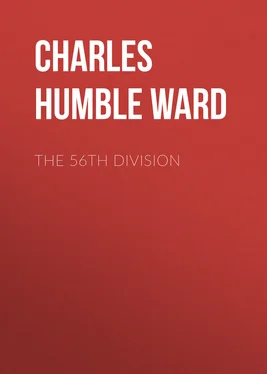Charles Humble Dudley Ward - The 56th Division
Здесь есть возможность читать онлайн «Charles Humble Dudley Ward - The 56th Division» — ознакомительный отрывок электронной книги совершенно бесплатно, а после прочтения отрывка купить полную версию. В некоторых случаях можно слушать аудио, скачать через торрент в формате fb2 и присутствует краткое содержание. Жанр: foreign_prose, История, foreign_edu, foreign_antique, на английском языке. Описание произведения, (предисловие) а так же отзывы посетителей доступны на портале библиотеки ЛибКат.
- Название:The 56th Division
- Автор:
- Жанр:
- Год:неизвестен
- ISBN:нет данных
- Рейтинг книги:5 / 5. Голосов: 1
-
Избранное:Добавить в избранное
- Отзывы:
-
Ваша оценка:
- 100
- 1
- 2
- 3
- 4
- 5
The 56th Division: краткое содержание, описание и аннотация
Предлагаем к чтению аннотацию, описание, краткое содержание или предисловие (зависит от того, что написал сам автор книги «The 56th Division»). Если вы не нашли необходимую информацию о книге — напишите в комментариях, мы постараемся отыскать её.
The 56th Division — читать онлайн ознакомительный отрывок
Ниже представлен текст книги, разбитый по страницам. Система сохранения места последней прочитанной страницы, позволяет с удобством читать онлайн бесплатно книгу «The 56th Division», без необходимости каждый раз заново искать на чём Вы остановились. Поставьте закладку, и сможете в любой момент перейти на страницу, на которой закончили чтение.
Интервал:
Закладка:
(1) From Feud through Ems to the Cemetery inclusive.
(2) About the Maze.
(3) About the south-east corner of Gommecourt Park.
The second phase of the 169th Brigade attack will take place immediately after the first phase.
The objective of the second phase is the Quadrilateral of the trenches in the south-east portion of K5a. The artillery lifts will be timed on the assumption that the infantry will reach Ems (between Etch and Fillet) twenty-five minutes after zero; and Exe (between Etch and Fillet) twenty-seven minutes after zero time.
The third phase will take place directly after the Quadrilateral is captured, and will consist of the securing of the cross-trenches at K5a78 (where Indus crosses Fill and Fillet) and joining hands with the 46th Division along Fill. Fillet will be consolidated facing east.
The following will be carried on the man:
200 rounds S.A.A.;
Waterproof sheet;
Haversack;
Iron ration and current day’s ration;
Two to three sand-bags;
Two tube helmets;
Proportion of wire-cutters, bill-hooks, tools.”
The instructions for the 167th Brigade are practically embodied in the following paragraphs:
“One company 167th Brigade will be placed at the disposal of the Brigadier-General commanding 169th Brigade, to hold sectors Y49 and Y50.
Seven officers and 200 men of the 167th Brigade will be detailed for the control of smoke, and will be under the orders of the Divisional Gas Officer. Approximately 1,200 men will be required for work under the C.R.E. on communication trenches across No Man’s Land and for carrying parties.”
Practice attacks, based on these instructions, were carried out by the brigades in reserve.
We have written of the constructive preparations which were going on all along the line of proposed attack. These preparations were continued until the last moment. But meanwhile another element was introduced—that of destructive preparation. It is scarcely necessary to point out that neither form of preparation could be concealed from the enemy. The Germans knew as well as we did where we would attack.
The Gommecourt sector to be attacked was held by the German 169th and 170th Regiments, with about 1-1/2 battalions on the front line, 1 battalion in support, 2 battalions in reserve in Bucquoy, and 2 companies at Ablainzeville. Their artillery consisted of 5 batteries of heavy artillery and 12 batteries of field artillery. These batteries were divided into three groups at Quesnoy Farm, on the left of the British position, Biez Wood and Puisieux. There was a further group of guns near Adinfer Wood which could assist in the defence.
The 56th Divisional Artillery, together with the heavy VII Corps guns, had now to prepare for the infantry assault by smashing up not only the wire and trench system, but billets and gun positions behind the German lines as well. As regards villages, most attention was given to Bucquoy, Essart, Ablainzeville, and Achiet-le-Grand.
Three groups of artillery were formed—a northern group, under Lieut.-Col. Southam, a southern group, under Lieut.-Col. Macdowell, and a wire-cutting group under Lieut.-Col. Prechtel. The northern and southern groups were under the orders of the Corps, and consisted of:
3 batteries of 18-pounders (until zero day, then 4 batteries).
1 battery 4·5 howitzers.
Affiliated at zero to the 169th Brigade.
4 batteries of 18-pounders.
1 battery 4·5 howitzers.
Affiliated at zero to the 168th Brigade.
5 batteries of 18-pounders until zero and then 4 batteries.
1 battery 4·5 howitzers.
Two of the guns of the 4·5 battery will be at the call of the counter-battery group.
In the preliminary instructions it will be noticed that a party of officers and men were detailed to act under the Divisional Gas Officer. Their special duty was to cover the approach of the infantry by the discharge of a smoke cloud. It was hoped to introduce some element of surprise by occasional discharges of smoke during the preparatory bombardment, and so the Corps ordered that the bombardment should be carried out for a period of five days, and the attack would take place on the sixth. These days would be known as U, V, W, X, Y, and Z days.
“Smoke discharges lasting for a period of ten minutes will take place on the days and at the hours mentioned below. They will coincide with the intense artillery bombardment of the enemy trenches. These bombardments will commence thirty minutes before the smoke, and will reach their maximum intensity during the ten minutes that it is being discharged:
U day, no discharge.
V day, no discharge.
W day from 10.15 a.m. to 10.25 a.m.
X day from 5.45 a.m. to 5.55 a.m.
Y day from 7.15 a.m. to 7.25 a.m.
On Z day the smoke cloud will commence five minutes before zero. On the 46th and 56th Divisional fronts its duration will be as arranged by divisions. On the 37th Divisional front it will continue for one hour.”
U day was the 24th June, but the whole of the great attack was postponed for two days, so that, instead of having five days of the preliminary bombardment, there were seven.
Naturally the Germans did not sit still under this destructive fire, but retaliated on our front line and trench system, and on our rear organisation. The enemy artillery had been active during the month of May, and the division had suffered in casualties to the extent of 402; for the month of June casualties leapt up to 801. The end of June was a prolonged crash of guns. Only for one half-hour, from 4 p.m., did the guns cease so that aeroplanes might take photographs of the German lines, and then the sky was speckled with the puffs of smoke from the German anti-aircraft guns.
The guns of the 56th Division fired altogether 115,594 rounds, of which 31,000 were fired on Z day. To this total must be added the work of the Corps heavy artillery. The 6-inch, 9·2-inch, and 15-inch fired on V day 3,200 rounds, on W day 2,200 rounds, on X day 3,100 rounds, and on Y day 5,300 rounds (which was repeated on the two extra days) at the front-line trenches and strong points. 6-inch, 9·2-inch, 4·7-inch, 4·5-inch, and 60-pounder guns also dealt with the villages of Bucquoy, Achiet-le-Grand, Essart, and Ablainzeville, but in nothing like the same proportion of rounds.
The first smoke cloud was discharged on the 26th June, and drew very little hostile machine-gun fire. The enemy lines were reported to be much damaged on that day. On the 27th the smoke discharge was somewhat spoilt by the premature bursting of a smoke shell an hour before the appointed time. This misfortune caused the enemy to put down a barrage on our front-line and communication trenches, which prevented the smoke detachments getting to their appointed positions. When the cloud was eventually discharged there was a large gap in the centre of it, so it must have been obvious to the enemy that it was only a feint.
The continual bombardment became more intense, and the enemy reply more vigorous. On the 28th the enemy wire was reported as satisfactorily cut in front of their first and second lines. Observers also noted that there was considerable movement of troops behind the German lines.
Every night, the moment it was dark, although the artillery still pounded trenches, roads, and tracks, patrols crept forward to ascertain what progress had been made in the battering down of defences. 2/Lieut. P. Henri, of the 3rd London Regt., raided the front line. He found the Germans working feverishly to repair their trench, and succeeded in capturing one prisoner, who proved to be of the Labour Battalion of the 2nd Reserve Guards Division. He reported that the wire in some places still formed a considerable obstacle.
Читать дальшеИнтервал:
Закладка:
Похожие книги на «The 56th Division»
Представляем Вашему вниманию похожие книги на «The 56th Division» списком для выбора. Мы отобрали схожую по названию и смыслу литературу в надежде предоставить читателям больше вариантов отыскать новые, интересные, ещё непрочитанные произведения.
Обсуждение, отзывы о книге «The 56th Division» и просто собственные мнения читателей. Оставьте ваши комментарии, напишите, что Вы думаете о произведении, его смысле или главных героях. Укажите что конкретно понравилось, а что нет, и почему Вы так считаете.




![Александр Ирвин - Tom Clancy’s The Division 2. Фальшивый рассвет [litres]](/books/417744/aleksandr-irvin-tom-clancy-s-the-division-2-falsh-thumb.webp)







